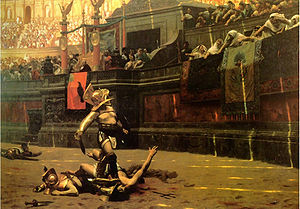
Murmillo
Encyclopedia

Gladiator
A gladiator was an armed combatant who entertained audiences in the Roman Republic and Roman Empire in violent confrontations with other gladiators, wild animals, and condemned criminals. Some gladiators were volunteers who risked their legal and social standing and their lives by appearing in the...
during the Roman Imperial age
Roman Empire
The Roman Empire was the post-Republican period of the ancient Roman civilization, characterised by an autocratic form of government and large territorial holdings in Europe and around the Mediterranean....
. The murmillo-class gladiator was adopted in the early Imperial period to replace the earlier Gallus, named after the warriors of Gaul
Gaul
Gaul was a region of Western Europe during the Iron Age and Roman era, encompassing present day France, Luxembourg and Belgium, most of Switzerland, the western part of Northern Italy, as well as the parts of the Netherlands and Germany on the left bank of the Rhine. The Gauls were the speakers of...
. As the Gauls inhabiting Italy had become well-integrated with the Romans by the time of the reign of Augustus
Augustus
Augustus ;23 September 63 BC – 19 August AD 14) is considered the first emperor of the Roman Empire, which he ruled alone from 27 BC until his death in 14 AD.The dates of his rule are contemporary dates; Augustus lived under two calendars, the Roman Republican until 45 BC, and the Julian...
, it became undesirable to portray them as enemy outsiders; the Gallus-class gladiator thus had to be retired.
The distinguishing feature of the murmillo was the high crest of his helmet which, together with its broad rim, was shaped somewhat like a fish. The murmillo took his name from this fish-shaped helmet; the word comes from murma, a Greek word for a type of saltwater fish.
Otherwise, he wore a loincloth (subligaculum), belt (cintus), very thick wrappings on the lower part of his left leg (designed to protect the top of his feet from attack and from his own shield), a gaiter on his right leg, a linen arm guard (manica
Manica (armour)
The Latin word "manica" means a sleeve. A manica was a type of iron or bronze arm guard, with curved and overlapping metal segments or plates, fastened to leather straps, worn by Roman gladiators called crupellarii, and later by soldiers....
) to protect his right arm, and the curved rectangular shield (scutum
Scutum (shield)
Scutum is the Latin word for "shield", although it has in modern times come to be specifically associated with the rectangular, semi-cylindrical body shield carried by Roman legionaries.-History:...
) of the Roman legionary
Legionary
The Roman legionary was a professional soldier of the Roman army after the Marian reforms of 107 BC. Legionaries had to be Roman citizens under the age of 45. They enlisted in a legion for twenty-five years of service, a change from the early practice of enlisting only for a campaign...
. He also carried the legionary's short, straight-blade sword, or gladius
Gladius
Gladius was the Latin word for sword, and is used to represent the primary sword of Ancient Roman soldiers. Early ancient Roman swords were similar to those used by the Greeks. From the 3rd century BC, the Romans adopted swords similar to those used by the Celtiberians and others during the early...
, from which gladiators derived their name.
The murmillo usually fought the thraex
Thraex
The Thraex , or Thracian, was a type of Roman gladiator, armed in the Thracian style with small rectangular shield called a parmula and a very short sword with a slightly curved blade called a sica , intended to maim an opponent's unarmoured back...
or hoplomachus
Hoplomachus
A Hoplomachus was a type of gladiator in ancient Rome, armed to resemble a Greek hoplite...
, with whom he shared some of the equipment (notably arm guards and all-enclosing helmet, and the dangerous short sword). A number of ancient authors, including Valerius Maximus
Valerius Maximus
Valerius Maximus was a Latin writer and author of a collection of historical anecdotes. He worked during the reign of Tiberius .-Biography:...
and Quintillian, assert that he also regularly fought the retiarius
Retiarius
A retiarius was a Roman gladiator who fought with equipment styled on that of a fisherman: a weighted net , a three-pointed trident , and a dagger...
. It would certainly have been an unusual pairing, contrasting a slow but heavily armoured gladiator with a fast but lightly equipped one. However, this pairing is disputed; visual depictions of murmillones show them fighting the thraex or hoplomachus rather than the retiarius.
Examples of the pairing between murmillones and other gladiator types can be seen in frescoes and graffiti in Pompeii
Pompeii
The city of Pompeii is a partially buried Roman town-city near modern Naples in the Italian region of Campania, in the territory of the comune of Pompei. Along with Herculaneum, Pompeii was destroyed and completely buried during a long catastrophic eruption of the volcano Mount Vesuvius spanning...
. In one well-preserved example, a murmillo named Marcus Atillus, who is credited with one match and one victory, is depicted standing over the defeated figure of Lucius Raecius Felix, a gladiator with 12 matches and 12 victories. His opponent is shown kneeling, disarmed and unhelmeted. The graffito records that Felix survived the fight and was granted his freedom (manumission
Manumission
Manumission is the act of a slave owner freeing his or her slaves. In the United States before the passage of the Thirteenth Amendment to the United States Constitution, which abolished most slavery, this often happened upon the death of the owner, under conditions in his will.-Motivations:The...
).
External links
- James Grout: Murmillo, part of the Encyclopædia Romana

